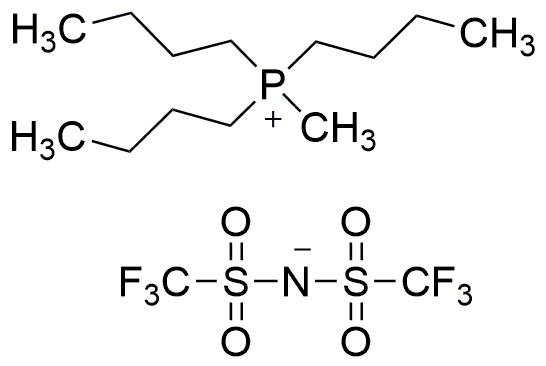Tributylmethylphosphonium bis(trifluoromethanesulfonyl)imide is widely utilized in research focused on:
- Electrolytes in Energy Storage: This compound serves as an effective electrolyte in lithium-ion and other types of batteries, enhancing energy efficiency and stability.
- Green Solvents: It is used in developing environmentally friendly solvents for chemical reactions, reducing the use of harmful organic solvents in industrial processes.
- Catalysis: The chemical acts as a catalyst in various organic reactions, improving reaction rates and yields, which is beneficial in pharmaceutical synthesis.
- Ion-Conducting Membranes: It is incorporated into ion-conducting membranes for fuel cells, contributing to improved performance and longevity of the cells.
- Separation Technologies: This compound is applied in separation processes, such as liquid-liquid extraction, to efficiently separate valuable compounds in chemical manufacturing.
General Information
Properties
Safety and Regulations
Applications
Tributylmethylphosphonium bis(trifluoromethanesulfonyl)imide is widely utilized in research focused on:
- Electrolytes in Energy Storage: This compound serves as an effective electrolyte in lithium-ion and other types of batteries, enhancing energy efficiency and stability.
- Green Solvents: It is used in developing environmentally friendly solvents for chemical reactions, reducing the use of harmful organic solvents in industrial processes.
- Catalysis: The chemical acts as a catalyst in various organic reactions, improving reaction rates and yields, which is beneficial in pharmaceutical synthesis.
- Ion-Conducting Membranes: It is incorporated into ion-conducting membranes for fuel cells, contributing to improved performance and longevity of the cells.
- Separation Technologies: This compound is applied in separation processes, such as liquid-liquid extraction, to efficiently separate valuable compounds in chemical manufacturing.
Documents
Safety Data Sheets (SDS)
The SDS provides comprehensive safety information on handling, storage, and disposal of the product.
Product Specification (PS)
The PS provides a comprehensive breakdown of the product’s properties, including chemical composition, physical state, purity, and storage requirements. It also details acceptable quality ranges and the product's intended applications.
Certificates of Analysis (COA)
Search for Certificates of Analysis (COA) by entering the products Lot Number. Lot and Batch Numbers can be found on a product’s label following the words ‘Lot’ or ‘Batch’.
*Catalog Number
*Lot Number
Certificates Of Origin (COO)
This COO confirms the country where the product was manufactured, and also details the materials and components used in it and whether it is derived from natural, synthetic, or other specific sources. This certificate may be required for customs, trade, and regulatory compliance.
*Catalog Number
*Lot Number
Safety Data Sheets (SDS)
The SDS provides comprehensive safety information on handling, storage, and disposal of the product.
DownloadProduct Specification (PS)
The PS provides a comprehensive breakdown of the product’s properties, including chemical composition, physical state, purity, and storage requirements. It also details acceptable quality ranges and the product's intended applications.
DownloadCertificates of Analysis (COA)
Search for Certificates of Analysis (COA) by entering the products Lot Number. Lot and Batch Numbers can be found on a product’s label following the words ‘Lot’ or ‘Batch’.
*Catalog Number
*Lot Number
Certificates Of Origin (COO)
This COO confirms the country where the product was manufactured, and also details the materials and components used in it and whether it is derived from natural, synthetic, or other specific sources. This certificate may be required for customs, trade, and regulatory compliance.


